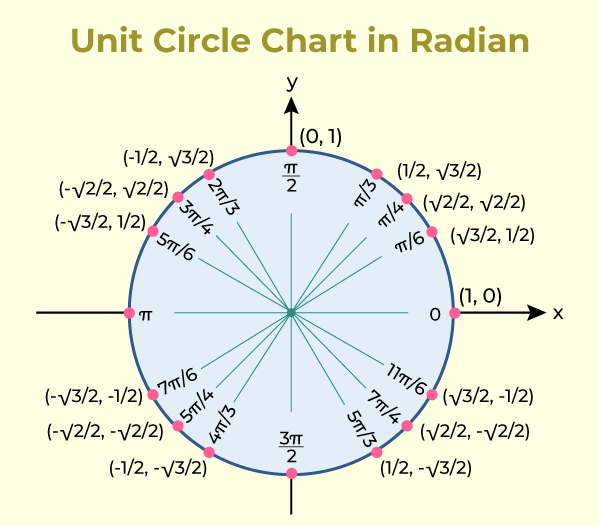
|
|
Trigonometry on the unit circle is a fundamental concept that ties together geometry and algebra with the study of angles and their associated trigonometric functions. In this article, we will learn what Unit Circle Trigonometry is, also solve some problems, etc. Table of Content What is Unit Circle Trigonometry?Unit Trigonometry refers to the study of trigonometric functions using the unit circle, a circle with a radius of one-centred at the origin of a coordinate plane. In this approach, angles are measured in radians and their sine, cosine, and tangent values are derived based on their coordinates on the unit circle. For instance, the cosine of an angle is the x-coordinate of the point where the terminal side of the angle intersects the unit circle, and the sine is the y-coordinate. Unit trigonometry simplifies calculations and provides a clear geometric interpretation of trigonometric functions.
Unit circle is a circle with a radius of 1, centred at the origin of a coordinate plane. It’s used to define trigonometric functions for all real numbers. Formula For Unit CircleAny point P on the unit circle can be described in terms of its coordinates (x,y). Since the radius of the unit circle is 1, the coordinates of any point on the circle satisfy the following equation: x2 + y2 = 1 This equation is derived from the Pythagorean theorem, considering that the radius is the hypotenuse of a right-angled triangle with legs x and y.
Trigonometric Functions on Unit circleVarious trigonometric function on unit circle are: Sine Function (sin): Represents the y-coordinate of the point P on the unit circle. sin(θ) = y Cosine Function (cos): Represents the x-coordinate of the point P on the unit circle. cos(θ) = x Tangent Function (tan): Represents the ratio of sine to cosine on the unit circle. tan(θ) = sin(θ)/cos(θ) Unit Circle-Trigonometry: Practice ProblemsP1. Solve for x in the equation 2sin(x)-1=0. Solution:
P2. Find tan(60∘). Solution:
P3. If sin(A)=3/5, find cos(A)and tan(A). Solution:
P4. Solve cos2(x) – sin2(x) = 1/2. Solution:
P5. Find tan(45∘). Solution:
P6. If sin(x)=4/5, find cos(x). Solution:
Practice Questions on Unit Circle-TrigonometryQ1. If cos(x) = 1/2, find x in the range 0∘ to 360∘. Q2. Solve sin(x) = 0. Q3. Find cot(30∘). Q4. Find the reference angle for 210∘. Q5. Find sin(90∘-θ). Q6. Find cos(2θ) using the double-angle formula. Q7. Find sin(120∘). Q8. Find sin2(x) + cos2(x) Applications of Unit Circle TrigonometrySome applications of unit circle trigonometry are:
ConclusionUnit circle trigonometry provides a foundational understanding of angles and their associated functions in both theoretical and practical contexts. It serves as a basis for more advanced topics in calculus, physics, and engineering, making it an essential concept in mathematics education. By visualizing angles as points on the unit circle and understanding their relationships through trigonometric functions, one gains insight into the fundamental properties of geometry and algebra. Frequently Asked QuestionsWhat is a Unit Circle?
Why is Unit Circle important in Trigonometry?
How are Sine and Cosine defined using the Unit Circle?
How is Tangent Function defined using Unit Circle?
How can Unit Circle be Used to Solve Real-World Problems?
What is Relationship between Unit Circle and Pythagorean Identity?
|
Reffered: https://www.geeksforgeeks.org
| Mathematics |
| Related |
|---|
| |
| |
| |
| |
| |
Type: | Geek |
Category: | Coding |
Sub Category: | Tutorial |
Uploaded by: | Admin |
Views: | 22 |